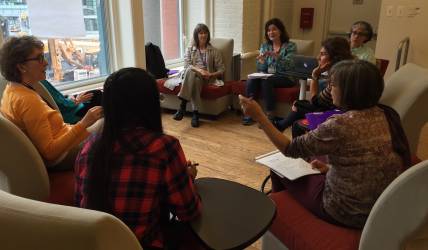Collective Leadership
While “leadership” often connotes an image of a single heroic leader, many interesting developments in the field treat the concept as a dynamic process of exchange between several actors embedded in networks of relationships going beyond leader and follower. This idea of collective leadership challenges the traditional notions in which individuals are the source of leadership. This perspective embraces the idea that many individuals within a system may lead, or that groups, structures, and processes may exercise leadership to help networks advance toward a shared goal.

Collective leadership describes the processes by which people come together to pursue change. Within these processes, participants jointly envision what the world should be, make sense of their experiences and interactions, and shape their decisions and actions to produce desired results. Leadership processes increase capacities for collaboration and provide conditions for group members to feel valued and motivated in contributing to collective goals. Leadership is thus a collective achievement.
This perspective on collective leadership is increasingly popular in the field of leadership studies. It shifts the focus from traditional leaders and their influence on other individuals and groups to: (1) the relational processes that produce leadership in a group, organization or system and (2) the broader system of relationships and the meaning-making, communicative and organizing processes that help to define and constitute these relationships.
Over the last decade, scholars of collective leadership have developed a deeper understanding of how leadership occurs as a social process embedded within a certain group. Because of its novelty, there are variations on how collective leadership is understood and used as a concept. Some approaches emphasize the work of creating environments to foster leadership among individuals in a group. Other approaches describe leadership as a property of the group. The group’s visible leader is one manifestation of leadership, but allows space for the emergence of other formal and informal leaders.
Hallmarks of Collective Leadership:
- Requires connecting people within diversity.
- Shapes the way audiences view their work and how they perceive themselves and others, and how they understand leadership itself.
- Commits to taking up leadership at all levels by people from all backgrounds, with varying perspectives and expertise.
- Can combine directive behaviors and collaborative approaches.
- Aims to transgress boundaries that are often taken for granted.
Resources
Learn about the Collective Leadership Network (Co-Lead Net).
- Ospina, S. & E.G Foldy. Enacting Collective Leadership in a Shared-power world. In James Perry and Robert K. Christensen (Eds) Handbook of Public Administration, 3d Edition. Jossey-Bass, 2015.
- Ospina, Sonia. Training leaders for democratic governance: the experience of RCLA. In Pliscoff, C. (Ed). Teaching and learning Public Policy and Management in the Americas. Santiago, Chile: RIL ED. Pp 79-91. 2014 (In Spanish)
- Ospina, Sonia and Mary Uhl-Bien. Introduction. In Advancing relational leadership theory, eds. M. Uhl-Bien and S. Ospina. Greenwich, CT: Information Age. 2012.
- Ospina, Sonia and Mary Uhl-Bien. Chapter 1. In Advancing relational leadership theory, eds. M. Uhl-Bien and S. Ospina. Greenwich, CT: Information Age. 2012.
- Ospina, Sonia and Margo Hittleman. Chapter 8. Thinking sociologically about leadership. In Leadership Studies, The dialogue of disciplines., eds. M. Harvey and R. Riggio. 2011.
- Ospina, Sonia. The Nature of relational leadership: A multi-theoretical lens on leadership relationships and processes. In D. Day and J. Antonakis (Eds.), The Nature of Leadership, 2nd ed., 289-330. London: Sage. 2010 (third author with M. Uhl-Bien and J., Maslyn)
- Ospina, Sonia and Georgia Sorenson. Chapter 8. A Constructionist Lens on Leadership: Charting New Territory. The Quest for a General Theory of Leadership (2006) 188-204.